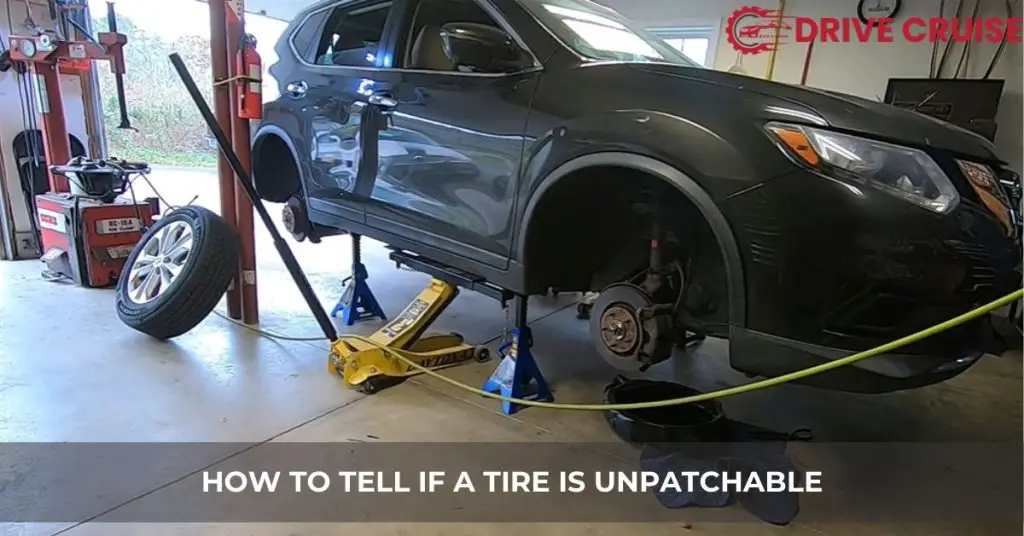We’ve all been there—driving along when suddenly, a tire goes flat. It’s a frustrating situation, but not all hope is lost if you can patch it up and be on your way. However, not every tire can be saved with a simple patch. Knowing when a tire is beyond repair is crucial to ensure your safety on the road.
So, how can you tell if a tire is unpatchable? It’s not always as clear cut as we’d like it to be. From the location and size of the puncture to the overall condition of the tire, several factors come into play. Join us as we dive into the signs that indicate a tire can’t be patched, saving you time and ensuring your journey remains a safe one.
Understanding Tire Damage
Following the exploration of when a tire might be beyond repair, it’s crucial to dive deeper into understanding the specifics of tire damage. By recognizing the types of damage and their implications, we can better assess whether a tire can be safely patched or if it necessitates replacement.
Location of the Damage: The location significantly affects a tire’s patchability. Damage to the tread area is typically repairable, provided it meets certain conditions. However, punctures in the sidewall or shoulder of the tire are generally deemed unpatchable. These areas undergo significant flexing and stress, making a lasting repair difficult to achieve.
Size and Shape of the Puncture:
- Size: A puncture smaller than 1/4 inch in diameter in the tread area can often be patched successfully. Anything larger compromises the tire’s structural integrity and is not safe to repair.
- Shape: Straight, clean punctures from a nail or a similar object are easier to repair. Jagged or irregular tears, especially those larger or elongated, pose challenges in creating a secure seal with a patch.
- Tread Depth: For a tire to be considered for patching, it must have adequate remaining tread depth. Tires with tread depth below 2/32 inches are unsafe and should be replaced rather than repaired.
- Age and Wear: Old tires, or those with signs of significant wear and tear, dry rot, or sidewall damage, are not good candidates for patching. Even if the puncture itself seems repairable, the overall condition of the tire may lead to future failures.
Through identifying and understanding these key aspects of tire damage, we can make informed decisions about the viability of patching a tire. Recognizing that not all damage is visible to the naked eye, professional inspection becomes paramount. A thorough examination by a tire specialist can reveal hidden damages, ensuring our decisions contribute to our safety on the road.
Key Indicators of an Unpatchable Tire
Following our discussion on the factors influencing a tire’s patchability, we’ll delve deeper into the specific indicators that signal a tire is unpatchable. Recognizing these signs can save us time and ensure our safety on the road.
Location of the Damage
- Sidewall and Shoulder Injuries: Damage in these areas is a clear indicator that a tire can’t be patched. The sidewall and shoulder endure significant flexing and stress, making patches unreliable.
- Bead Damage: If the damage is to the tire’s bead (the edge that sits on the wheel), it’s unpatchable. The bead holds the tire to the rim, and any compromise here affects the tire’s ability to stay securely mounted.
Size and Shape of the Puncture
- Larger than 1/4 Inch: Punctures wider than 1/4 inch (approximately 6mm) in diameter are beyond a safe patching size. Larger holes compromise the tire’s structural integrity.
- Irregular Shapes: Slashes or cuts that aren’t circular can’t be effectively sealed with a standard patch, making the tire unsafe for further use.
Tread Depth
- Below 2/32 Inch: Tires with a tread depth of 2/32 inch or less are considered legally worn out in many places. Even if a patch were possible, it’s time for a replacement due to safety concerns.
- Visible Dry Rot or Cracks: Aging tires showing signs of dry rot or cracks in the rubber, especially deep ones, are unsafe. Patching won’t resolve these issues.
- Multiple Punctures: Tires with multiple punctures, particularly if close together, undermine the tire’s structure, making it unsafe to patch.
By understanding and identifying these key indicators, we’re better equipped to make informed decisions when we encounter tire damage. Always opting for a thorough inspection by a professional is crucial, as they can assess the extent of damage beyond what’s visible to the naked eye and recommend the safest course of action. Ensuring our tires are in good condition is integral to road safety, so when in doubt, it’s best to replace an unpatchable tire.
The Dangers of Ignoring Unpatchable Tires
Identifying an unpatchable tire is crucial, but understanding the risks of ignoring these issues is equally important. Addressing tire damage promptly ensures not only our safety but also the safety of other road users. Ignoring unpatchable tires can lead to several hazardous situations.
First, driving on a damaged tire significantly increases the risk of a blowout. Blowouts happen suddenly and can cause us to lose control of the vehicle, potentially leading to an accident. This risk escalates when traveling at high speeds on highways, where maintaining control is critical.
Second, compromised tires can negatively impact vehicle handling. An undetected unpatchable tire might not provide the necessary grip, especially on wet or slippery roads. This reduction in traction can result in longer stopping distances and reduced cornering ability, making it harder to avoid obstacles or stop in emergencies.
Third, fuel efficiency suffers when driving with damaged tires. A compromised tire can increase rolling resistance, forcing the engine to work harder and consume more fuel. This not only hits our wallets but also contributes to higher emissions.
Finally, ignoring tire damage can exacerbate wear on other vehicle components. For example, uneven tire wear can lead to misalignment, which in turn affects suspension and steering components, increasing maintenance costs over time.
Acknowledging these dangers, it’s imperative we act responsibly by regularly checking our tires for damage and consulting professionals when we suspect a tire might be unpatchable. Taking these steps not only ensures our safety but also contributes to the overall well-being of everyone on the road.
Professional Tire Inspection and Repair
After understanding the key factors that render a tire unpatchable, it’s vital to stress the importance of professional tire inspection and repair. When faced with a potentially unpatchable tire, seeking advice from experts becomes an indispensable step. Here’s what happens during a professional inspection, and how specialists determine the best course of action.
During an inspection, professionals perform a comprehensive evaluation of the tire’s condition. They examine the tire for any signs of excessive wear, deep punctures, or damage to critical areas like the sidewall, shoulder, and bead. Technicians use specialized tools to measure tread depth accurately, ensuring it meets safety standards. If the tire’s condition falls below these standards, they’ll recommend replacement instead of repair.
Professionals also assess the size and shape of the puncture. Punctures larger than 1/4 inch in diameter generally exceed the safe repair limits. Similarly, irregular or elongated holes, which compromise the tire’s structural integrity, are typically deemed unrepairable.
Another critical aspect of professional tire repair is ensuring the repair is performed correctly. Technicians follow industry standards, such as the Rubber Manufacturers Association (RMA) guidelines, which dictate how repairs should be made to ensure safety and durability. For instance, a high-quality repair involves removing the tire from the rim to patch and plug the damage from the inside, a method that’s proven to restore the tire’s integrity effectively.
Furthermore, professionals can offer valuable advice on tire maintenance and how to prevent future damage. They might suggest alignment checks, rotations, and maintaining proper tire pressure to extend the life of your tires.
By consulting with a tire repair specialist, you ensure your vehicle remains safe to drive. Ignoring professional advice or delaying tire inspection and repair can compromise road safety, potentially leading to more severe consequences.
DIY Tips for Tire Maintenance
In line with emphasizing the significance of addressing tire damage promptly and the crucial role of professional inspections, we believe it’s equally important to share some DIY tips for tire maintenance. Undertaking regular checks can significantly extend the lifespan of your tires, ensure your vehicle’s safety, and possibly prevent tires from becoming unpatchable.
Visually Inspect Tires Regularly
Make it a habit to visually inspect your tires at least once a month. Look for signs of uneven wear, cracks, or objects embedded in the tread. These indicators could suggest alignment issues, the need for rotation, or potential punctures that might worsen over time.
Maintain Proper Tire Pressure
Check your tire pressure monthly and before long trips or when carrying extra load. Incorrect tire pressure can lead to poor fuel economy, compromised handling, increased wear, and susceptibility to puncture damage. Use a reliable tire pressure gauge and inflate your tires according to the manufacturer’s recommendations found in your vehicle’s manual or on the door jamb.
Rotate Tires Regularly
Rotating your tires as recommended—typically every 5,000 to 7,000 miles—ensures even tire wear and extends tire life. An uneven worn tire is more prone to damage and less likely to be patchable if punctured.
Monitor Tread Depth
Keeping an eye on tread depth is crucial for safety and tire integrity. A simple way to check tread depth is the penny test: insert a penny into the tread groove with Lincoln’s head facing down. If you can see the top of Lincoln’s head, it’s time to replace the tire. Worn treads increase the risk of punctures and make tires unpatchable.
By implementing these DIY maintenance tips, you’re not only ensuring your tires remain in good condition but also reducing the chances of encountering unpatchable tire damage. Regular upkeep, combined with professional evaluations for any concerns, forms the cornerstone of effective tire management and road safety.
Conclusion
We’ve explored the vital signs of unpatchable tires and the importance of not overlooking these warning signals. Remember, it’s not just about fixing a tire; it’s about ensuring our safety and that of others on the road. By adopting regular maintenance habits and seeking professional advice when needed, we’re not just extending the life of our tires but also contributing to a safer driving environment. Let’s stay vigilant, maintain our tires well, and drive with peace of mind knowing we’ve done our part in tire care and safety.
Related Posts:







